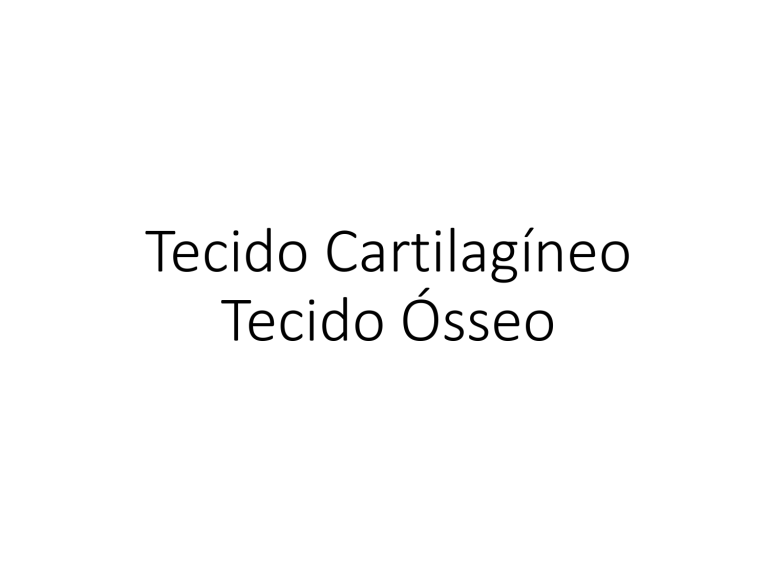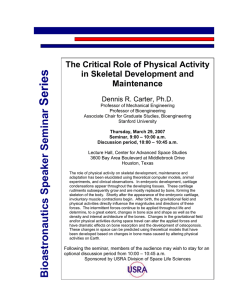Cartilage & Bone Histology: Types, Formation, & Structure
advertisement

Tecido Cartilagíneo Tecido Ósseo Cartilagem Hialina Hyaline cartilage provides structural support in the respiratory system (larynx, trachea and bronchi). The airway of the trachea is held open by cartilaginous rings of hyaline cartilage: •Perichondrium - a layer of dense irregular connective tissue that surrounds cartilage. It is divided into two layers: • Outer Fibrous Layer - contains fibroblasts that produce the type I collagen on the outer surface of the perichondrium. • Inner Chondrogenic Layer - contains fibroblast-like cells that can differentiate into chondroblasts, initiate matrix production (type II collagen) and become immature chondrocytes. •Chondrocytes - cells within lacunae inside the cartilage that occur singularly or in clusters called isogenous groups. •Matrix - composed mostly of type II collagen and a ground substance of proteoglycans. • Territorial Matrix - basophilic area immediately around chondrocytes. • Interterritorial Matrix - less intensly stained area between isogenous groups of chondrocytes. Hyaline cartilage contains no blood vessels or nerves. Cartilagem Elástica Elastic and hyaline cartilage have similar appearances when stained by H&E because elastic fibers are unstained. Compare with the next specimen stained with Verhoeff's. Elastic cartilage forms the core of the epiglottis: •Perichondrium - a layer of dense irregular connective tissue that surrounds cartilage. It is divided into two layers: • Outer Fibrous Layer - fibroblasts that produce the type I collagen on the outer surface of the perichondrium. • Inner Chondrogenic Layer contains mesenchymal cells that differentiate into chondroblasts, initiate matrix production (elastin and type II collagen) and become immature chondrocytes. Cartilagem Fibrosa Intervertebral discs that are found between adjacent vertebrae of the spine contain fibrocartilage. They have a fibrous appearance of mostly collagen fibers with interspersed areas of cartilage. (Note that the cytoplasm has been extracted from most of the cells during sample preparation.) •Collagen Fibers - the majority of the fibrocartilage is a mixture of type I and type II collagen. They type I collagen is stained pink/red. •Fibroblasts - scattered cells within fibrous regions with elongated or flattened nuclei. Few are seen in this specimen. •Chondrocytes - are dispersed between collagen fibers singularly, in columns, or in isogenous groups and are surrounded by a basophilic matrix. •Matrix - much less material surrounds each chondrocyte than in hyaline cartilage. It is composed of type II collagen and a ground substance of proteoglycans. The basophilia is due to a high content of sulfated glycosaminoglycans (GAGs). •There is no perichondrium. Fibrocartilage contains no blood vessels or nerves. Ossificação Endocondral PE CH Endochondral bone formation occurs at the epiphyseal plate of long bones. It can be identified by the layer of basophilic hyaline cartilage. •Resting Zone - thin layer of non-dividing chondrocytes. •Proliferative Zone - rapidly dividing chondrocytes (basophilic) that organize into distinct columns ("stacks of coins"). •Zone of Hypertrophy - chondrocytes (basophilic) cease dividing and grow in size. The cartilage matrix forms (lightly basophilic) linear bands between the columns of hypertrophied cells. •Zone of Calcification - the cartilage matrix becomes calcified inhibiting the diffusion of nutrients. The dying chondrocytes are removed leaving longitudinal spicules of calcified cartilage (intensely basophilic). •Zone of Ossification - osteoprogenitor cells migrate into the cavities with the new blood vessels. New bone (eosinophilic) forms on the scaffold of calcified cartilage (basophilic). Ossificação Intramembranosa Different stages of intramembranous bone formation are seen in the skull cap (calvarium) when moving from the center to the right. •Condensation - mesenchymal cells migrate and aggregate into areas where bone will form (a bone blastema). •Osteoprogenitor Cells - the condensation of mesenchymal cells initiates the differentiation of osteoprogenitor cells. •Osteoblasts - the synthesis of components of the bone matrix indicates the further differentiation of osteoprogenitor cells into osteoblasts. Their basophilic cytoplasm is from the synthesis of proteins in osteoid (mostly type I collagen). •Osteoid - unmineralized, organic portion (type I collagen and ground substance) of bone matrix. Narrow, light-pink region between osteoblasts and the bone spicule. •Osteocytes - osteoblasts trapped inside lacunae of the bone. •Bone spicules - composed of women immature (or primary) bone with mineralized osteoid that is more basophilic than unmineralized osteoid. •Trabeculae - form from bone spicules that fuse with each other to provide the general shape of a developing bone. Tecido ÓSSEO COMPACTO Osteon Ground section of bone stained with Schmorl's stain to reveal small, open spaces in the bone. The higher contrast allows the fine structure of bone to be seen in excellent detail. Osso Esponjoso •Spongy (or cancellous) Bone - trabeculae of woven immature (or primary) bone. The osteocytes and collagen fibers are randomly arranged in the mineralized osteoid. • Osteoblasts - found on the surface of some bone spicules. • Mesenchymal and Osteoprogenitor Cells - found in tissue between bone spicules. • Osteoclasts - large, multinucleated cells that remove bone tissue. They form a resorption bay when attached to bone. • Haversian System - little evidence of osteons characteristic of mature (or secondary) bone. A few developing osteons can be found. Osteons are arranged parallel with the lines of stress in mature bone. •Marrow Cavity - filled with developing blood cells. Observar Cartilagem, Osso • Cartilagem Hialina • traqueia • Cartilagem Elástica • orelha • Fibrocartilagem • Tecido Ósseo • Compacto • Esponjoso • Desenvolvimento endocondral (cartilagineo) • Desenvolvimento intramembranoso



